Alexandra Bellow facts for kids
Quick facts for kids
Alexandra Bellow
|
|
|---|---|

Bellow in 1975
|
|
| Born |
Alexandra Bagdasar
August 30, 1935 |
| Died | May 2, 2025 (aged 89) Chicago, Illinois, U.S.
|
| Nationality | Romanian American |
| Alma mater | University of Bucharest Yale University |
| Spouse(s) |
Cassius Ionescu-Tulcea
(m. 1956; div. 1969) |
| Scientific career | |
| Fields | Mathematics |
| Institutions | University of Pennsylvania University of Illinois at Urbana–Champaign Northwestern University |
| Thesis | Ergodic Theory of Random Series (1959) |
| Doctoral advisor | Shizuo Kakutani |
Alexandra Bellow (born Alexandra Bagdasar; August 30, 1935 – May 2, 2025) was a Romanian-American mathematician. She made important contributions to areas of mathematics like ergodic theory, probability, and analysis.
Contents
Her Life Story

Alexandra Bagdasar was born in Bucharest, Romania, on August 30, 1935. Her parents were both doctors. Her mother, Florica Bagdasar, was a child psychiatrist. Her father, Dumitru Bagdasar, was a brain surgeon.
Alexandra earned her master's degree in mathematics from the University of Bucharest in 1957. There, she met and married her first husband, mathematician Cassius Ionescu-Tulcea.
In 1957, she moved to the United States with her husband. She received her Ph.D. from Yale University in 1959. Her main teacher was Shizuo Kakutani. Her Ph.D. paper was about "Ergodic Theory of Random Series."
After getting her degree, she worked at Yale from 1959 to 1961. She then became an assistant professor at the University of Pennsylvania from 1962 to 1964. From 1964 to 1967, she was an associate professor at the University of Illinois at Urbana–Champaign.
In 1967, she joined Northwestern University as a Professor of Mathematics. She taught there until she retired in 1996. After retiring, she became a Professor Emeritus, which means she kept her title as a respected former professor.
During her marriage to Cassius Ionescu-Tulcea (1956–1969), they wrote many math papers together. They also wrote a research book on "lifting theory."
Alexandra's second husband was the famous writer Saul Bellow. He won the Nobel Prize in Literature in 1976 while they were married (1975–1985). Alexandra appeared in some of his writings. She was shown in his memoir To Jerusalem and Back (1976). She also appeared in his novel The Dean's December (1982) and Ravelstein (2000).
In 1989, Alexandra married mathematician Alberto Calderón. This period was very fulfilling for her, both personally and professionally.
Alexandra Bellow passed away in Chicago, Illinois, on May 2, 2025. She was 89 years old.
Her Mathematical Work
Alexandra Bellow's work focused on several complex areas of mathematics. She made important discoveries in ergodic theory, probability, and analysis.
Lifting Theory
Some of her early work was about "lifting theory." This area of math helps understand how certain mathematical objects can be "lifted" or represented in a simpler way. She and her first husband, Cassius Ionescu-Tulcea, wrote a key book on this topic in 1969. This book became a standard reference for other mathematicians.
Their work helped to simplify how we understand certain random processes. It also showed how to make complex functions easier to work with.
Martingales
In the early 1960s, Alexandra Bellow studied "martingales." These are mathematical models often used in probability theory to describe fair games or random processes. Her work helped start the study of martingales that involve more complex mathematical spaces. She proved that these martingales behave in a predictable way under certain conditions. This opened up a new field of study called "geometry of Banach spaces."
She later expanded these ideas to "uniform amarts." These are a more general type of martingale. They are very stable and useful in probability theory.
Ergodic Theory
Alexandra Bellow also did important work in ergodic theory. This field studies the long-term average behavior of systems. For example, it can help predict what happens over a very long time in a chaotic system.
She showed that some unusual examples of mathematical transformations were actually quite common. Her work used methods from a field called "Baire category."
In the 1980s, she started a new series of papers. These papers helped to bring new life to the study of "pointwise convergence" in ergodic theory. This is about whether a sequence of mathematical values gets closer and closer to a single point. She used ideas from probability and harmonic analysis to explore these questions.
She also posed two important problems at a math meeting in 1981. One question was about whether a specific math rule (the pointwise ergodic theorem) worked for certain sequences of numbers, like "squares" or "primes." A famous mathematician named Jean Bourgain later solved parts of this problem. Bourgain won the Fields Medal in 1994, partly for this work.
Alexandra Bellow also showed that some sequences of numbers, called "lacunary sequences," are "bad universal sequences" in certain mathematical contexts. This means they can cause the pointwise ergodic theorem to fail. This was a surprising discovery. She also showed that a sequence could be "good" in one mathematical space but "bad" in another.
She and her colleagues also studied the "strong sweeping out property." This describes situations where mathematical averages do not behave as expected. This property is important for understanding when mathematical models might not predict real-world systems accurately.
Many mathematicians, including Jean Bourgain, worked on problems that Alexandra Bellow had first suggested.
Awards and Recognition
Alexandra Bellow received many honors for her work:
- 1977–80: Member of the Visiting Committee for the Harvard University Mathematics Department.
- 1980: Fairchild Distinguished Scholar Award at California Institute of Technology.
- 1987: Humboldt Prize from the Alexander von Humboldt Foundation in Germany.
- 1991: Emmy Noether Lecture in San Francisco. This is a special lecture honoring women in mathematics.
- 1997: An international conference was held in her honor at Northwestern University when she retired.
- 2017: She was named a Fellow of the American Mathematical Society. This was for her contributions to analysis, ergodic theory, and measure theory.
Professional Activities
Alexandra Bellow also helped guide mathematical publications:
- 1974–77: Editor for the Transactions of the American Mathematical Society.
- 1980–82: Associate Editor for Annals of Probability.
- 1979–: Associate Editor for Advances in Mathematics.
See also

